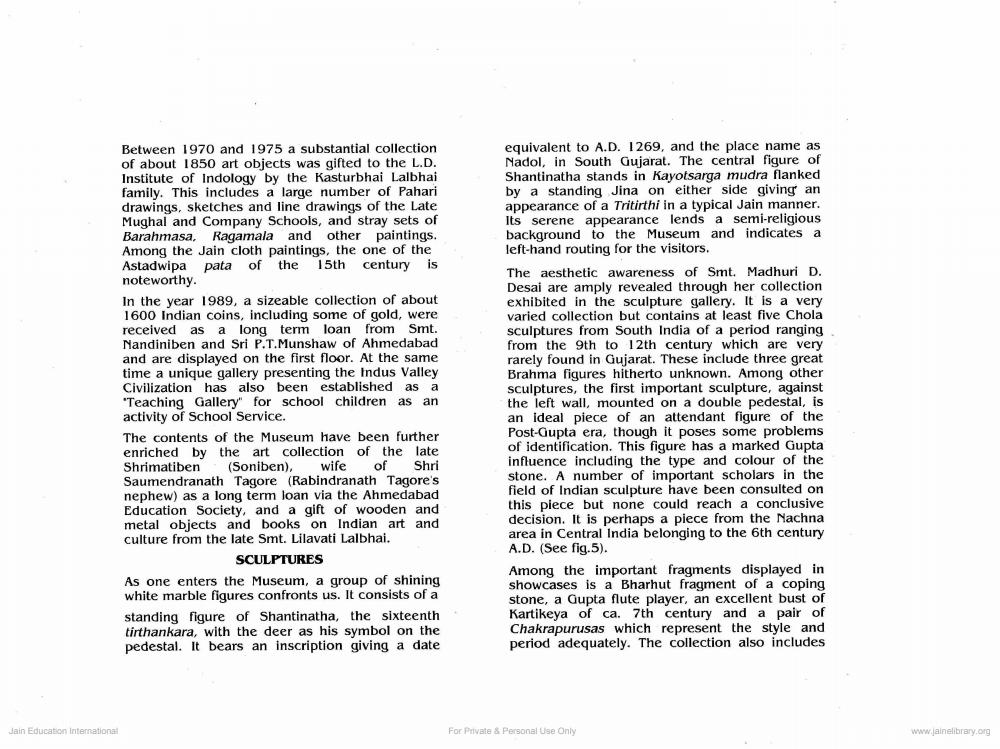Book Title: Treasures from the Lalbhai Dalpatbhai Museum Author(s): L D Indology Ahmedabad Publisher: L D Indology Ahmedabad View full book textPage 6
________________ Between 1970 and 1975 a substantial collection of about 1850 art objects was gifted to the L.D. Institute of Indology by the Kasturbhai Lalbhai family. This includes a large number of Pahari drawings, sketches and line drawings of the Late Mughal and Company Schools, and stray sets of Barahmasa, Ragamala and other paintings. Among the Jain cloth paintings, the one of the Astadwipa pata of the 15th century is noteworthy. In the year 1989, a sizeable collection of about 1600 Indian coins, including some of gold, were received as a long term loan from Smt. Nandiniben and Sri P.T.Munshaw of Ahmedabad and are displayed on the first floor. At the same time a unique gallery presenting the Indus Valley Civilization has also been established as a 'Teaching Gallery" for school children as an activity of School Service. The contents of the Museum have been further enriched by the art collection of the late Shrimatiben (Soniben), wife of Shri Saumendranath Tagore (Rabindranath Tagore's nephew) as a long term loan via the Ahmedabad Education Society, and a gift of wooden and metal objects and books on Indian art and culture from the late Smt. Lilavati Lalbhai. SCULPTURES As one enters the Museum, a group of shining white marble figures confronts us. It consists of a standing figure of Shantinatha, the sixteenth tirthankara, with the deer as his symbol on the pedestal. It bears an inscription giving a date equivalent to A.D. 1269, and the place name as Nadol, in South Gujarat. The central figure of Shantinatha stands in Kayotsarga mudra flanked by a standing Jina on either side giving an appearance of a Tritirthi in a typical Jain manner. Its serene appearance lends a semi-religious background to the Museum and indicates a left-hand routing for the visitors. The aesthetic awareness of Smt. Madhuri D. Desai are amply revealed through her collection exhibited in the sculpture gallery. It is a very varied collection but contains at least five Chola sculptures from South India of a period ranging from the 9th to 12th century which are very rarely found in Gujarat. These include three great Brahma figures hitherto unknown. Among other sculptures, the first important sculpture, against the left wall mounted on a double pedestal, is an ideal piece of an attendant figure of the Post-Gupta era, though it poses some problems of identification. This figure has a marked Gupta influence including the type and colour of the stone. A number of important scholars in the field of Indian sculpture have been consulted on this piece but none could reach a conclusive decision. It is perhaps a piece from the Nachna area in Central India belonging to the 6th century A.D. (See fig.5). Among the important fragments displayed in showcases is a Bharhut fragment of a coping stone, a Gupta flute player, an excellent bust of Kartikeya of ca. 7th century and a pair of Chakrapurusas which represent the style and period adequately. The collection also includes Jain Education International For Private & Personal Use Only www.jainelibrary.orgPage Navigation
1 ... 4 5 6 7 8 9 10 11 12 13 14 15 16 17 18 19 20 21 22 23 24 25 26 27 28 29 30 31 32
